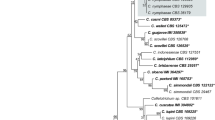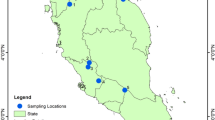Abstract
Colletotrichum gloeosporoides has been described as the causal agent of Colletotrichum leaf disease of rubber in Sri Lanka and other parts of the world since 1905. A study carried out on vegetative and reproductive characteristics of 52 isolates from Colletotrichum leaf disease lesions on Hevea brasiliensis in Sri Lanka revealed that only 18 isolates belong to Colletotrichum gloeosporioides. The remaining 34 isolates represented C. aculatum indicating that C. acutatum is the main cause of Colletotrichum leaf disease in Sri Lanka.
Similar content being viewed by others
References
Hilton RN. Maladies ofHeveain Malaya. Kuala Lumpur, Rubber Research Institute of Malaya, 1959.
Wastie RL. Gloeosporiumleaf disease of rubber in West Malaysia. Planter 1967; 43: 553-565.
Anon. Host list of plant-diseases recorded in the South East Asia and Pacific region, Hevea brasiliensis-Rubber. Plant Protection Committee for the South East Asia and Pacific region. F.A.O. Technical Document No. 7 (2nd ed) Bangkok, Thailand, 3 pp, 1960.
Petch T. Description of new Ceylon fungi. Annual Report of Botanical Gardens, Peradeniya 1906; 3: 1-10.
Weir JR. A pathological survey of the Para rubber tree (Hevea brasiliensis) in the Amazon valley. United States Department of Agriculture Bulletin 1926; 1380: 129 pp.
Wastie RL. Glomerella cingulata, Colletotrichum dematiumand C. crassipeson Heveain West Malaysia. Plant Protection Bulletin F.A.O 1968; 16: 10-13.
Mitra M, Mehta PR. Diseases of Hevea brasiliensisnew to India. Indian Journal of Agricultural Science 1938; 8: 185-188.
Keuchenius AAMN. Overzicht van de ondernemings - cultures in het rayon West-Sumatra gedurende 1938. Bergcultures 1939; 13: 569-576.
Wimalajeewa DLS. The significance of the factors affecting spore germination in the spread of Gloeosporiumleaf disease of Hevea. Quarterly Journal Rubber Research Institute Ceylon 1965; 41: 63-69.
Wimalajeewa DLS, Lloyd JH. The incidence and economic importance of the Gloeosporiumleaf disease of Hevea. In Ceylon. Part 1. Planter's assessment. Quarterly Journal Rubber Research Institute Ceylon 1963; 39: 18-24.
Brown AE, Soepena H. Pathogenicity of Colletotrichum acutatumand C. gloeosporioideson leaves of Heveaspp. Mycological Research 1994; 98: 264-266.
Gunnell PS, Gubler WD. Taxonomy and morphology of Colletotrichumspecies pathogenic to strawberry. Mycologia 1992; 84: 157-165.
Smith BJ, Black LL. Morphological, cultural and pathogenic variation among Colletotrichumspecies isolated from strawberry. Plant Disease 1990; 74: 69-76.
Simmonds JH. A study of the species of Colletotrichumcausing ripe fruit rots in Queensland. Queensland Journal of Agricultural and Animal Sciences 1965; 22: 437-459.
Denoyes B, Baudry A. Species identification and pathogenicity study of French Colletotrichumstrains isolated from strawberry using morphological and cultural characteristics. Phytopathology 1995; 85: 53-57.
Dyko BJ, Mordue JEM. Colletotrichum acutatum.CMI descriptions of pathogenic fungi and bacteria. No. 630. Commonwealth Mycological Institute, Kew, UK, 2 pp, 1979.
Mordue JEM. Glomerella cingulata.CMI descriptions of pathogenic fungi and Bacteria. No. 315. Commonwealth Mycological Institute, Kew, UK, 2 pp, 1971.
Arx JA Von. Die arten der gattung ColletotrichumCda. (The species of the genus Colletotrichum). Phytopathology Zeitschrift 1957; 29: 413-468.
Peries OS, Wimalajeewa DLS. The control of Gloeosporiumleaf disease of Heveain Ceylon. Tropical Agriculturist Trinidad 1970; 47: 227-228.
Senaratna LK, Wijesundera RLC, Liyanage AdeS. Morphological and physiological characters of two isolates of Colletotrichum gloeosporioidesfrom rubber (Hevea brasiliensis).Mycological Research 1991; 95: 1085-1089.
Author information
Authors and Affiliations
Rights and permissions
About this article
Cite this article
Jayasinghe, C., Fernando, T. & Priyanka, U. Colletotrichum acutatum is the main cause of Colletotrichum leaf disease of rubber in Sri Lanka. Mycopathologia 137, 53–56 (1997). https://doi.org/10.1023/A:1006850119146
Issue Date:
DOI: https://doi.org/10.1023/A:1006850119146




